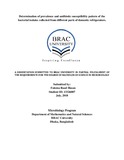| dc.contributor.advisor | Jahan, Nazneen | |
| dc.contributor.advisor | Department of Mathematics and Natural Sciences, BRAC University | |
| dc.contributor.author | Hasan, Fatema Raad | |
| dc.date.accessioned | 2018-12-02T07:43:06Z | |
| dc.date.available | 2018-12-02T07:43:06Z | |
| dc.date.copyright | 2018 | |
| dc.date.issued | 2018-07 | |
| dc.identifier.other | ID 13326007 | |
| dc.identifier.uri | http://hdl.handle.net/10361/10928 | |
| dc.description | This thesis is submitted in partial fulfilment of the requirements for the degree of Bachelor of Science in Microbiology, 2018. | en_US |
| dc.description | Catalogued from PDF version of thesis report. | |
| dc.description | Includes bibliographical references (page 51-53). | |
| dc.description.abstract | Refrigerator form an important link in wide chain of cross contamination which leads to the
outbreak of domestic food borne disease.In this study samples were obtained from various parts
(drawer,handle,egg tray,surface) of domestic refrigerators of various parts of Mohakhali and
Mirpur area, Dhaka, Bangladesh. A total of 37 isolates collected from 8 different parts were
identified. Identification of bacteria was done through conventional biochemical tests according
to Bergey’s Manual of Systematic Bacteriology. Antibiotic susceptibility pattern of all isolates
were performed against nine commercial antibiotic discs [Ampicillin (10 μg), Ciprofloxacin (5
μg), Chloramphenicol (30 μg), Gentamycin (10 μg), Azithromycin (15μg), Penicillin-G (10 μg),
Nalidixic acid (30 μg), Streptomycin (10μg), Tetracycline (30 μg)] by using Kirby-Bauer disc
diffusion method. A total of 37 isolates had been identified where Staphylococcus spp.and
Klebsiella spp.showed the highest prevalence 8(21.62%), next to Pseudomonas spp
5(13.5%).,E.coli 5(13.5%), Salmonella spp 5 (13.5%), Bacillus spp. 2 (5.4%) and Vibrio spp. 4
(10.8%). Ampicillin showed the highest resistance percentage (81.08%) for most of the isolates.
Out of 37 bacterial isolates, (29.72%) were resistant to more than two antibiotics. We also
determined temperature tolerance of the organisms by growing the isolates in different temperature
like 45°C,50°C and 55°C. All the isolates showed growth at 45°C but in 50°C and 55°C only
(54.05%) and (10.81%) isolates showed viable growth. These results indicate that the presence of
these organisms, including potential foodborne pathogens, in domestic refrigerators portends
serious health implications. It is needed to maintain appropriate food storage and refrigerator
management, and proper hand hygiene is recommended. | en_US |
| dc.description.statementofresponsibility | Fatema Raad Hasan | |
| dc.format.extent | 63 pages | |
| dc.language.iso | en | en_US |
| dc.publisher | BRAC University | en_US |
| dc.rights | BRAC University theses are protected by copyright. They may be viewed from this source for any purpose, but reproduction or distribution in any format is prohibited without written permission. | |
| dc.subject | Bacterial isolates | en_US |
| dc.subject | Refrigerators | en_US |
| dc.subject | Antibiotic | en_US |
| dc.subject.lcsh | Antibiotics | |
| dc.subject.lcsh | Bacteriology | |
| dc.title | Determination of prevalence and antibiotic susceptibility pattern of the bacterial isolates collected from different parts of domestic refrigerators | en_US |
| dc.type | Thesis | en_US |
| dc.contributor.department | Department of Mathematics and Natural Sciences, BRAC University | |
| dc.contributor.department | Department of Mathematics and Natural Sciences, BRAC University | |
| dc.description.degree | B. Microbiology | |

